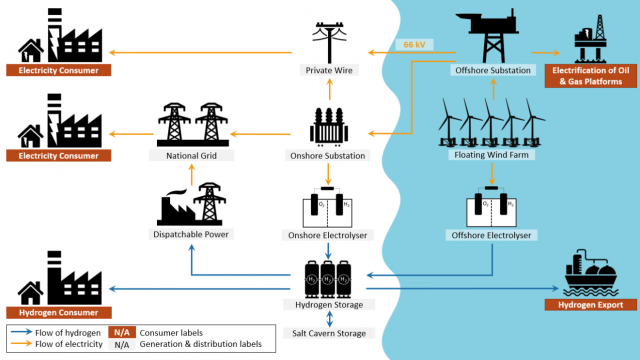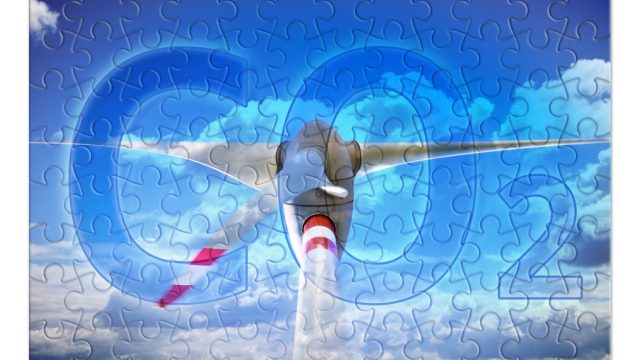Offshore Wind Turbines: Is Bigger, Better?
Published January 2023
Offshore wind turbines have grown in size significantly over the past 20 years. In this blog, Everoze Partner Graeme Wilson explores whether the industry is going to continue to scale up at historical rates or if are we beginning to see signs in the market that we’ll soon reach an asymptote. And how might floating offshore wind impact the perceived historical wisdom, that bigger is better?
Are bigger offshore wind turbines better? Well, historically the answer has of course been yes, bigger WTGs are better. For lots of reasons – including many both technical and economical. This combined with a hyper-competitive offshore wind market, has driven OEMs to continuously up-scale their platforms in an almost cold war-like arms race.
The speed of development has been staggering. No sooner has project A announced they have selected a new 15 MW WTG, Project B announces they’ve gone with a rival OEM’s 17 MW model. And on it goes on. Even Chinese manufacturers are getting in on the game with Mingyang recently announcing an 18 MW WTG.
Although all of us know the technical challenges that go with upscaling and the incredible work by the engineers working to design these monsters, it is starting to feel very normal now. Much like Premier League transfer fees, for me, the numbers are becoming harder to appreciate.
I remember when the Siemens 6 MW WTG was launched, and it felt monumental. But somehow it feels like we’ve gone from an 11 MW to a 14 MW model, in the blink of an eye. Scale-up is happening so regularly and seemingly effortlessly, that there’s a slight feeling of the Gillette 3000 about it.
Regardless, if the economic advantage of larger WTGs is undeniable, this trend is surely set to continue, right?
Well, I’m beginning to think that this rate of scale-up could soon slow down – we may soon be approaching an asymptote of sorts.
This is partly because the risks posed by scale-up are becoming harder to ignore, and also because I think we’re soon to see a significant technological change coming.
Downside 1 – Quality
There is, I believe, mounting evidence that WTG reliability and quality are suffering potentially as a result of the speed of scale-up.
It was announced very recently, that Siemens Gamesa has been hit by increased failure rates in its installed fleet. Based on their public statements, it is not currently clear exactly how impacted their newer, offshore fleet, is impacted by these failure rates. However, the press release does make reference to its warranty provisions, indicating this issue may be affecting newer machines still under warranty.
As well as the Siemens Gamesa reported issues, Vestas is also reporting serious losses due to « warranty provisions », with the CEO stating « We can’t live with this« . They also state there is an impairment on its V174 offshore unit.
These reliability issues have been exasperated by market-wide issues including disruption to the O&M supply chain and significant increases in the price of marine logistics – partially driven by the oil and gas sector (see downside 2 below). OEMs will have to stomach these cost increases due to the scope of their warranties.
In my view, if scale-up continues whilst quality is compromised, offshore wind OEMs are in danger of participating in a race to the bottom. There is a risk, despite all the progress made over the past 20 years, that we may see a repeat of something of the scale and impact caused by the V90 gearbox issue which plagued Vestas and the wider offshore wind industry 15 years ago.
Downside 2 – Vessels
As WTGs have increased in size and weight, so have their foundations. Monstrous vessels such as the Saipem 7000 and HMC Thialf are now required to lift monopile and jacket foundations and large jack-ups are required to install and repair WTGs.
Day rates for heavy lift and jack-up vessels were already relatively high before 2022, but now inflation, high oil prices and both scarcity and increased competition with other wind farms have made this more expensive.
Availability of vessels has now become a construction and operations bottleneck driving vessel owners to build new vessels, develop new concepts or make expensive crane upgrades. These investments have not all gone according to plan and some projects, built on the basis of the availability of new vessels or innovations, have suffered.
Vessel owners also need to consider the WTG market when designing their vessels, and rapid scale-up makes this difficult. Added to this, the European market has been the primary beneficiary of vessel investment over the past 10 years – this may change soon as the US market (constrained by the Jones Act) ramps up, swallowing investment.
Despite both Downside 1 and 2, truth be told I can’t see OEMs pausing on WTG upscaling in the immediate future. Developers have to do all they can to ensure projects progress and those who gamble on bigger WTGs will likely win CfD. The trend will continue for now. Bigger will be better for some time yet.
However… floating offshore wind could soon change this, even in a hyper-competitive market.
Floating
Floating will – in my view – cause developers and OEMs to totally re-evaluate this « bigger is better » philosophy. Not just because of the downsides discussed above, but primarily because of the upsides that come with continuity and homogeneity, which will be of particular value in floating offshore wind.
To understand these upsides it’s important to understand three things about floating which are fundamentally different to fixed-bottom wind.
The first is obvious…
1. Floating wind turbines are not fixed
Major component replacements are a significant cost in fixed-bottom wind, and they will be even more significant for floating offshore wind. Floating offshore wind opens the opportunity for tow-to-port maintenance. This will allow heavy lift operations to be carried out onshore in a controlled environment and means floating projects could be less impacted by high vessel costs, the likes of which the fixed market is seeing now.
However, there is one very significant problem with this idea, and that is the lack of availability of ports. Currently, there is insufficient infrastructure to manage two-to-port (T-2-P) on a large scale, this will take considerable time to build up, and the port infrastructure must be designed to be compatible with various types of floater design – on which the industry is yet to coalesce. Spar buoys have very different port requirements to tension leg platforms (TLPs) for example.
The alternative to T-2-P is a floating-to-floating (F-2-F) exchange using a heavy lift vessel. This would allow floating wind to grow unhindered by the port infrastructure issues, but would mean floating projects would be subject to the same vessel market volatility and scarcity as the fixed bottom market.
There is an alternative option though… interchangeable floating wind turbines.
What if, when the OEM sold a project their WTGs, they also sold them a service, where they would provide the project with a floating WTG (both WTG and floater) which they could connect into your project as they were removing the one being taken away for repair? You would lose minimal production and the OEM could manage the O&M centrally – allowing for significant savings on both logistics, materials and port infrastructure costs.
This would only work however if the floating WTG being plugged in, imported and exported power in the same way as the one which was taken away for repair. For this to be feasible there must therefore be some consistency across the OEM’s rolling stock of floating WTG, including of course the rated capacity and power curve of the WTG.
WTG reliability is currently a big area of risk for floating offshore wind and we have seen that the warranties on offer, currently, do not all provide developers or investors with significant comfort. OEMs include significant carve-outs and low availability guarantees, due to the risk of lack of port infrastructure, lack of common network disconnection and re-connection procedures, lack of experience of below water work, and the availability of onshore crawler cranes and tug vessels.
OEMs could offer strong warranties if the design of floating WTGs was common across multiple projects by taking this interchange WTG or rolling stock approach. Partnerships with large marine contractors would also allow them to contract aspects of this scope they are not comfortable with. However, for a service like this to be offered and for it to make financial sense, there must be commonality across their fleet of floating WTGs.
WTG OEMs can’t influence how the industry coalesces around floating concepts, but they can influence the size of WTGs on offer, and there’s another reason why floating offshore wind may cause a low down in scale-up.
2. WTG fabrication, delivery and installation are fundamentally different for floating offshore wind
Fixed bottom projects tend to fabricate, deliver and then install WTGs over two successive seasons.
This is not possible for large floating wind projects because the floating structure manufacturing process and WTG installation process are both bottlenecks.
Most floater designs are huge and have greater similarity to vessels than fixed-bottom foundations. The time and space required to fabricate and assemble the floaters will be significantly greater than fixed-bottom. Once fabricated it is not clear how or where they might be stored until the WTGs are installed either onshore or offshore. It does not seem feasible that a large floating wind farm would store its 50 or so floaters in a fjord or bay until all WTGs are delivered for installation.
It is more likely, in my opinion, that you will see floating wind farms built in batches over many years. This could mean 10 floating WTGs being delivered and commissioned every year for 5 years, rather than 50 foundations and WTGs being installed in two successive seasons, as we would expect for fixed-bottom projects.
This bottleneck is why, for me, the TetraSpar floating concept from Stiesdal is so interesting, as it is designed with fabrication in mind. They too, however, will still require significant storage space and will likely need to be delivered for WTG installation in small batches.
If this small batch installation program is used by developers to overcome this storage issue, it is likely that OEMs will deliver the same WTG model to multiple projects over a much longer period, rather than fabricate for one wind farm at a time in a production line as they do now. This slow delivery rate isn’t sustainable for the OEMs unless they fabricate and deliver for multiple projects at once.
In my view, this likely means that OEMs will need to continue with their production lines for a much longer period than they do currently. This will force the rate of scale-up to slow, or at least become less smooth.
3. Bigger Floating WTGs means, “We’re gonna need a bigger boat”
Bigger WTGs will mean bigger floating foundations, which could result in a higher overall system CapEx which may not be offset by increased yield.
For bottom fixed WTGs, a bigger WTG will mean a bigger, wider and longer metal cylinder. This increase in cost will be offset by other economies of scale, aided by the fact there is an existing infrastructure to produce monopiles at scale very quickly.
For floating offshore wind, a structure must be scaled which bears a greater resemblance to the design of a ship than a monopile or jacket. Should economies of scale be achievable, it will require significant orders and large, numerous and expensive production facilities – all of which could be more easily achieved if the floaters were designed for one model of WTG.
Moorings will also be required which will be capable of handling these huge loads, and the engineering time and cost required to design and manufacture these will be very challenging if WTGs continue to scale up at speed.
WTG scale-up must slow to allow floating fabricators time to gain a foothold.
Conclusion
The drivers above indicate that there may soon be a slowing in WTG scale-up.
This presents opportunities to WTG OEMs, as they may find time to innovate elsewhere and therefore potentially adapt their business model. OEMs could soon start to focus more time on offering new innovative services to floating wind developers who can benefit from the rolling stock type nature of floating WTGs. These could be:
- Temporary over-planting services where projects could lease additional floating WTGs;
- Blade or other major component overhauls that can be carried out onshore whilst an inter-changeable floating WTG is used to offset lost production
- Development of a platform for assets to be sold or leased between projects or customers (a floating wind Air BnB);
- Offshore floating battery or hydrogen add-ons
- Changeable layouts: 1) as projects are built in phases, optimum layout changes as construction progresses and 2) during the operations phase when wind profile and direction change significantly from season to season
All this is to say that as amazing as the development of larger WTGs has been over the past 10 years or so, we may soon be reaching a point where developers and OEMs see the value in slowing things down.
Whether that happens before we reach a 50 MW WTG or not, is still uncertain…






